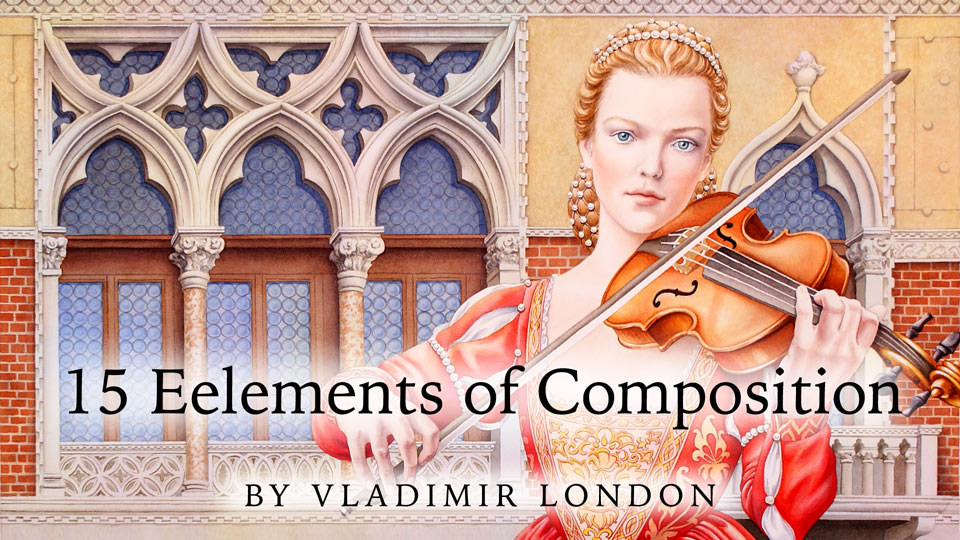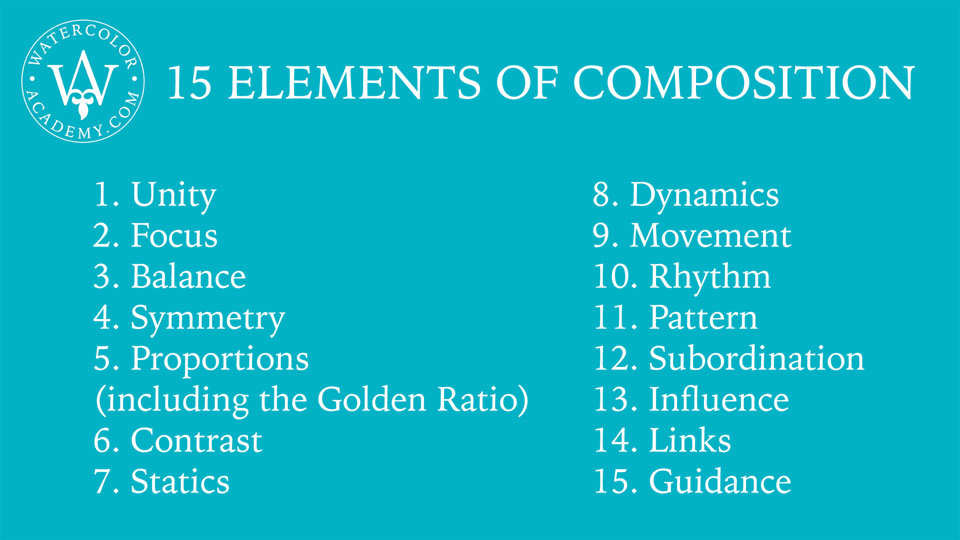A self-study, self-paced course where you can learn how to paint in watercolor by watching video lessons and doing assignments
$297 USD
ENROLL NOWA self-study, self-paced course where you can learn how to paint in watercolor by watching video lessons and doing assignments
$297 USD
ENROLL NOWOne-to-one, unlimited and custom-tailored to your skills and needs Personal Tutoring by the Watercolor Academy teachers
$997 USD
ENROLL NOWVideo lesson by Vladimir London
In this video lesson, you will learn about composition and how to use it in your watercolor artworks.

Here's what Wikipedia says about composition: "In the visual arts, composition is the placement or arrangement of visual elements or 'ingredients' in a work of art."
For an artwork to look pleasing, it should be composed in the right way. Now, we can talk about what the "right" way is.
Western art books list eight elements of composition. I don't think this is enough, so we will talk about 15 elements that help to build a good-looking artwork with a meaningfully presented subject. So, in my opinion, the main elements of composition are:

Don't worry if some points do not make sense yet. We will go through them one by one.
Unity is when an artwork looks like one whole and complete unit. No part can be added, shifted, or removed without ruining its beautiful appearance.
The focal center of an artwork is the spot that the viewer's eyes are drawn to. It is not necessarily the geometrical center of an artwork. Still, the focal center is the most important place in an artwork.
There are different ways to attract attention to focal points and we will discuss them in this lesson.
A composition is balanced when objects, tones, and colors are arranged so that no part feels heavier than another. Unbalanced compositions can create a feeling of unease.
Think of balance as weights. Bigger and darker objects are heavier than smaller and brighter ones. A heavy object can be balanced by a group of smaller objects.
A composition can be symmetrical or asymmetrical. Symmetrical arrangements are usually calmer, while asymmetry adds dynamism and movement.
Various cultures have different preferences when it comes to symmetry. For example, in Japanese art, asymmetrical compositions are the norm. Many Western artists often prefer to use a bold and symmetrical arrangement.
Here's my artwork in which symmetry makes the composition very static, balanced, and peaceful, and draws attention to the centrally located focal point—the model's face.
Proportion is the ratio of one dimension to another.
You've probably heard about the rule of thirds—when an artwork is divided into three equal parts and main objects are aligned according to the division. Other common ratios are three-fifth and three-eighths.
Things get beautiful when the ratio follows the golden mean, or the golden proportion. The golden ratio is an essential part of art. That is why we have dedicated a separate lesson to it.
Here are a few examples of how the golden ratio is used in my watercolor artworks.
Contrast is the juxtaposition of opposite qualities within one artwork, such as strong differences in shapes, sizes, tones, colors, textures, lines, and so on.
One artwork can have several contrasts, like light and dark tones, large and small shapes, or warm and cold colors.
Dynamics, the opposite of statics, bring feelings of unrest, instability, and energy into an artwork. Dynamic composition is achieved by using asymmetrical arrangement and the unordered placement of various objects.
Movement is similar to dynamics but has some direction from one point to another.
The trajectory of movement can be straight or curved. Movement can bring a sense of perspective; it can point attention to a focal center or portray figures in action.
The direction of movement can be optimistic or pessimistic. In Western cultures, in which texts are written from left to right, the diagonal direction from the lower-left to the upper-right is subconsciously perceived as optimistic and forward-looking, while the opposite diagonal from the top-left to the bottom-right is seen as pessimistic.
Rhythm is the underlying beat in music; it can be fast or slow. In art, it brings pace to an artwork.
For example, rhythm can be created with repetitive contrasts.Pattern is the ordered and regular repetition of design. Pattern in a composition can be created using lines, shapes, colors, and tones. Patterns contain rhythm.
Subordination in composition defines the relationship between objects. Some characters, objects, places, colors, tones, etc. can be superior or inferior in relation to each other.
For example, to portray an important figure, an artist can place it in a focal point of the composition, making all other figures subordinate. In this still-life, one object dominates the scene while others serve secondary roles.
This is how da Vinci composed his "Last Supper".
Here's another example in which Veronese tells the story of Alexander the Great.
Subordination also applies to colors, shapes, etc. In this still-life one object dominates the scene while others serve secondary roles.
Various objects in a composition and their placement can influence the appearance of other objects. This can be used to solve certain creative tasks.
For example, to make a warm-colored object appear even warmer, an artist can surround it with cold colors. Also, placing an object closer to the artwork's edge brings such an object closer to a viewer. And placing it near the middle of an artwork makes it appear further away.
Links connect the objects in a composition. Links can be visible lines like a wire between poles or a road crossing the countryside. A gaze or a gesture between figures can be a link, as well.
Links are another means of attracting attention to focal places.
All the elements of composition listed above can come together to tell a story and convey what an artist wants to say. They can guide a viewer to see an artwork the way it was intended.
For example, an artist may guide a viewer's gaze from one figure or an object to another and evoke feelings and thoughts along the way.
This is what composition is all about—composing an arrangement of visual elements to tell a story, induce emotions, and pass the message to viewers.
Now, you may ask how these 15 elements of composition can be used in your works of art. Where do you begin? What do you do?
I'll give you one very simple way to compose scenes...
A self-study, self-paced course where you can learn how to paint in watercolor by watching video lessons and doing assignments
One-time payment - Lifetime membership
$297 USD
One-to-one, unlimited and custom-tailored to your skills and needs Personal Tutoring by the Watercolor Academy teachers
One-time payment - Lifetime membership
$997 USD